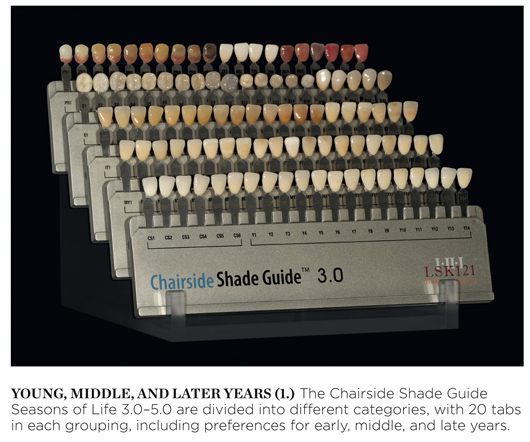LSK121 Chairside Shade Guide
Seasons of Life is a series of tabs porcelain ceramic tabs that match natural tooth colors and the existing dentition.
Luke Kahng, CDT, a technician for more than 20 years, first began researching the difficulties of shade matching a decade ago. He realized that traditional shade tabs are merely a guide—limited when it comes to communicating the natural dentition’s characteristics and modifications. However, the blueprint to successful restorations is communication between the patient, the clinician, and the laboratory about color.
As a result, the Chairside Shade Guide came into production 2009, with an updated version debuting in 2010. After continuous research toward improving the product, the current ceramic shade tabs are being introduced in 2012. The color formulas for these shade tabs have been researched, developed, and carefully recorded by Mr. Kahng.
The Chairside Shade Guide Seasons of Life 3.0–5.0 is a series of porcelain ceramic shade tabs that match natural tooth colors as well as the existing dentition. In graduating from laminated commercial paper to ceramic shade tabs, a more realistic color reproduction is possible because the materials are equal. Guesswork about how the final shade, including all modifications, will look when finished is a thing of the past. In addition, because these tabs are porcelain, they can be sterilized after each use.
The Seasons of Life Shade Tabs are divided into different categories, with 20 tabs in each grouping, including the following preferences:
Version 3.0
Historically, precise cosmetic color guidelines have not been available. What is accessible is not what patients want. They prefer bright color with translucency, light with warm tones. These tabs, Cosmetic (6 colors) and Young (14 colors), are created with that in mind. The enamel color is bright (white) and medium-white, covered together in natural dentition’s chemistry. There is also a higher composition of dentin with enamel overlay in this group. Opal, translucency, and variations of white calcification, different colors of mamelon, and bright enamel with higher dentin are all included.
Version 4.0
Middle Years (20 colors) includes variation and 20% to 30% reduction of color in enamel. Included are three white calcification possibilities and a variety of translucency with mamelon, demonstrating lower enamel and higher translucency color.
Version 5.0
In this age group, Later Years (20 colors), our dentin color is intense in appearance, with transparency over the top. Brown, orange, grey, and yellow are the color choices—subtle, moderate and heavy, with varying degrees of strength. These modifications and possible staining must be included if the restoration is to match.
Communication for Successful Restorations
Good communication improves case acceptance because patients value the dentist’s time and effort in educating them about their case. However, thorough explanations about natural color, translucency, transparency, and bright color in cosmetic and rehabilitation cases are difficult to discuss if we do not have the proper communication tools. These shade tabs can be used to help the clinician explain color variation with translucency. The more a patient knows about his case, the better informed he feels—which leads to a sense of understanding and empowerment.
How is the Shade Guide Used?
This revolutionary approach tracks different dentin and enamel colors by re-creating the layering thickness to mimic natural dentition, deep translucency, the mamelon effect, white calcification, and opal blue coloring. The precise components and dentin/enamel combinations create incisal translucency with modifications, duplicated precisely according to the research conducted with natural dentition and the appropriate age group. This system incorporates modifications such as enamel overlay and dentin color, incisal edge, halo, translucency, transparency, bleaching color, mamelon, and calcification and provides them in one shade tab. The clinician will never have to guess which modifications to add to the restoration because everything is already included.
Enamel presents with many variations in color—orange, grey, brown, and yellow are some of the more common possibilities. To mimic natural dentition, the colors have been mixed to create the complexity, tone, and depth of color seen in natural teeth. Detailed attention has been paid to the internal dentin color, the incisal edge, staining of the gingival one third, and the translucency or transparency—as dictated by age, LSK121’s in-depth research, and what is seen in the patient’s mouth. As a result, LSK121 is able to offer a true repetition of lifelike enamel colors.
Is the Shade Guide Effective?
Consider your patients’ natural dentition. There is no one set of teeth that looks exactly like another, but there are common modifications that are seen from patient to patient. Frustration when it comes to discussing color is common, but LSK121’s shade tabs are meant to help with patient/doctor/technician communication in a way that nothing else has before. These shade tabs are based completely on the theory behind custom shade matching and are each overlaid with different enamel colors so that they harmoniously match with natural teeth (Figure 1). The uniquely blended Seasons of Life shade tabs take in-office custom shade matching to a whole new level. This shade tab will match with natural teeth color the first time and every time.
For more information, contact:
LSK121
Phone: 888-405-1238
Web: www.lsk121.com
Disclaimer
The preceding material was provided by the manufacturer. The statements and opinions contained therein are solely those of the manufacturer and not of the editors, publisher, or the Editorial Board of Inside Dentistry.




